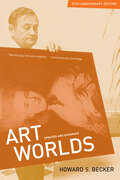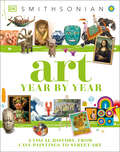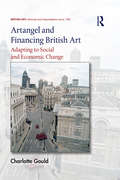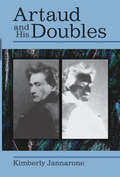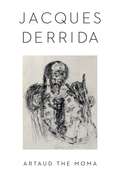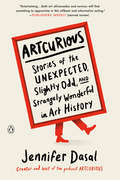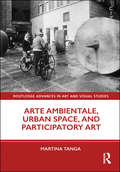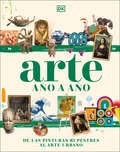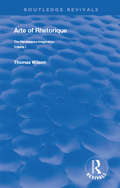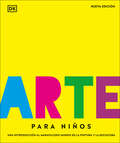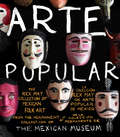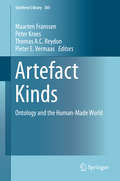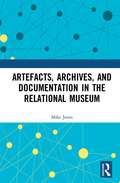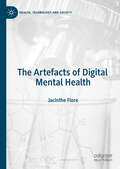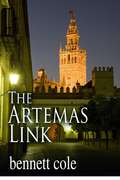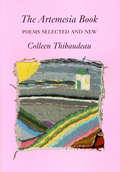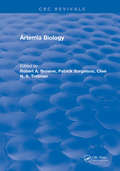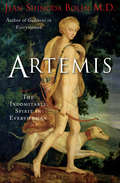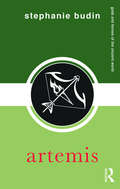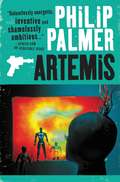- Table View
- List View
Art Worlds, 25th Anniversary Edition: 25th Anniversary edition, Updated and Expanded
by Howard S. BeckerThis classic sociological examination of art as collective action explores the cooperative network of suppliers, performers, dealers, critics, and consumers who—along with the artist—"produce" a work of art. Howard S. Becker looks at the conventions essential to this operation and, prospectively, at the extent to which art is shaped by this collective activity. The book is thoroughly illustrated and updated with a new dialogue between Becker and eminent French sociologist Alain Pessin about the extended social system in which art is created, and with a new preface in which the author talks about his own process in creating this influential work.
Art Year by Year: A Visual History, From Cave Paintings to Street Art
by DKTravel through time to discover the paintings, sculptures, and decorative objects that enrich our world.Are you seeking a lavishly illustrated timeline that showcases a glorious gallery of art from all around the world? Then SI Art Year By Year may be the book for you!Over 500 images of art movements such as the Renaissance, Neoclassicism, Impressionism, and Pop Art are explored and explained, accompanied by striking visual detail that truly brings the artwork to life. Further featuring biographies of the key figures behind some of the world&’s best-known artworks, from Botticelli and Hiroshige to Goncharova and Morisot, SI Art Year By Year has something for everyone to admire. With passion in every page, you can explore: - Feature panels discussing artists, art movements, and techniques- Specific works of art analysed, with details pulled out and explained- Pages that explore a single theme through time and across different cultures- Inspiring quotes from artists add insightWith every story plotted on a timeline, the pages give a snapshot of each era, and reveal the influences and connections behind the artworks and artistic movements that have reflected our world. With more than 500 images of paintings, drawings, photographs, and sculptures, SI Art Year by Year is the ultimate visual guide to the history of art, century by century, year by year!A must-have art book for children and adults alike who are curious about art, whether you&’re an educator, an art enthusiast, or a lover of creativity seeking to explore some of the greatest known artworks throughout history, SI Art Year By Year is sure to delight.
Artangel and Financing British Art: Adapting to Social and Economic Change (British Art: Histories and Interpretations since 1700)
by Charlotte GouldThe Artangel Trust has been credited with providing artists with all the money and logistics they need to create one-off dream projects. An independent art commissioning agency based in London, it has operated since 1985 and is responsible for producing some of the most striking ephemeral and site-specific artworks of the last decades, from Rachel Whiteread’s House to Jeremy Deller’s The Battle of Orgreave. Artangel’s existence spans three decades, which now form a coherent whole in terms of both art historical and political periodisation. It was launched as a reaction to the cuts in funding for the visual arts introduced by the Thatcher government in 1979 and has since adapted in a distinctive way to changing cultural policies. Its mixed economic model, the recourse to public, private and corporate funds, is the result of the more general hybridisation of funding encouraged by successive governments since the 1980s and offers a contemporary case study on broader questions concerning the specificities of British art patronage. This book aims to demonstrate that the singular way its directors have responded to the vagaries of public funding and harnessed new national attitudes to philanthropy has created a sustainable independent model, but also that it has been reflected more formally, in their approach to site. The locational art produced by the agency has indeed mirrored new distinctions between public and private spaces, it has reflected the social and economic changes the country has gone through and accompanied the new cultural geographies shaping London and the United Kingdom. Looking into whether their funding model might have had a formal incidence on the art they helped produce and on its relation to notions of publicness and privacy, the study of Artangel gives a fresh insight into new trends in British site-specific art.
Artaud and His Doubles
by Kimberly JannaroneArtaud and His Doublesis a radical re-thinking of one of the most influential theater figures of the twentieth century. Placing Artaud's writing within the specific context of European political, theatrical, and intellectual history, the book reveals Artaud's affinities with a disturbing array of anti-intellectual and reactionary writers and artists whose ranks swelled catastrophically between the wars in Western Europe. Kimberly Jannarone shows that Artaud's work reveals two sets of doubles: one, a body of peculiarly persistent received interpretations from the American experimental theater and French post-structuralist readings of the 1960s; and, two, a darker set of doubles—those of Artaud's contemporaries who, in the tumultuous, alienated, and pessimistic atmosphere enveloping much of Europe after World War I, denounced the degradation of civilization, yearned for cosmic purification, and called for an ecstatic loss of the self. Artaud and His Doubleswill generate provocative new discussions about Artaud and fundamentally challenge the way we look at his work and ideas.
Artaud the Moma (Columbia Themes in Philosophy, Social Criticism, and the Arts)
by Jacques DerridaIn 1996 Jacques Derrida gave a lecture at the Museum of Modern Art in New York on the occasion of Antonin Artaud: Works on Paper, one of the first major international exhibitions to present the avant-garde dramatist and poet's paintings and drawings. Derrida's original title, "Artaud the Moma," is a characteristic play on words. It alludes to Artaud's calling himself Mômo, Marseilles slang for "fool," upon his return to Paris in 1946 after nine years in various asylums, while playing off of the museum's nickname, MoMA. But the title was not deemed "presentable or decent," in Derrida's words, by the very institution that chose to exhibit Artaud's work. Instead, the lecture was advertised as "Jacques Derrida . . . will present a lecture about Artaud's drawings."For Derrida, what was at stake was what it meant for the museum to exhibit Artaud's drawings and for him to lecture on Artaud in that institutional context. Thinking over the performative force of Artaud's work and the relation between writing and drawing, Derrida addresses the multiplicity of Artaud's identities to confront the modernist museum's valorizing of originality. He channels Artaud's specter, speech, and struggle against representation to attempt to hold the museum accountable for trying to confine Artaud within its categories. Artaud the Moma, as lecture and text, reveals the challenge that Artaud posed to Derrida—and to art and its institutional history. A powerful interjection into the museum halls, this work is a crucial moment in Derrida's thought and an insightful, unsparing reading of a challenging writer and artist.
ArtCurious: Stories of the Unexpected, Slightly Odd, and Strangely Wonderful in Art History
by Jennifer DasalA wildly entertaining and surprisingly educational dive into art history as you've never seen it before, from the host of the beloved ArtCurious podcastWe're all familiar with the works of Claude Monet, thanks in no small part to the ubiquitous reproductions of his water lilies on umbrellas, handbags, scarves, and dorm-room posters. But did you also know that Monet and his cohort were trailblazing rebels whose works were originally deemed unbelievably ugly and vulgar? And while you probably know the tale of Vincent van Gogh's suicide, you may not be aware that there's pretty compelling evidence that the artist didn't die by his own hand but was accidentally killed--or even murdered. Or how about the fact that one of Andy Warhol's most enduring legacies involves Caroline Kennedy's moldy birthday cake and a collection of toenail clippings?ArtCurious is a colorful look at the world of art history, revealing some of the strangest, funniest, and most fascinating stories behind the world's great artists and masterpieces. Through these and other incredible, weird, and wonderful tales, ArtCurious presents an engaging look at why art history is, and continues to be, a riveting and relevant world to explore.
Arte Ambientale, Urban Space, and Participatory Art (Routledge Advances in Art and Visual Studies)
by Martina TangaWorking in 1970s Italy, a group of artists—namely Ugo La Pietra, Maurizio Nannucci, Francesco Somaini, Mauro Staccioli, Franco Summa, and Franco Vaccari—sought new spaces to create and exhibit art. Looking beyond the gallery, they generated sculptural, conceptual, and participatory interventions, called Arte Ambientale (Environmental Art), situated in the city streets. Their experiments emerged at a time of cultural crisis, when fierce domestic terrorism aggravated an already fragile political situation. To confront the malaise, these artists embraced a position of artistic autonomy and social critique, democratically connecting the city's inhabitants through direct art practices.
Arte año a año (Art Year by Year): De las pinturas rupestres al arte urbano
by DKEste excelente libro está recorrido de principio a fin por una sola línea cronológica, creando una fantástica galería de arte a través de la historia, desde las pinturas rupestres hasta el arte callejero, y mucho más.Se exploran y explican movimientos artísticos como el Renacimiento, el Impresionismo, el Surrealismo y el Pop Art. También hay biografías de las figuras clave tras algunas de las obras de arte más conocidas del mundo, desde Rembrandt hasta Rodin, Botticelli y Banksy. Con cada historia trazada en una línea temporal, las páginas de este libro ofrecen una fotografía instantánea de cada época y revelan las influencias y conexiones detrás de las obras de arte y movimientos artísticos que han reflejado nuestro mundo.Con más de 1,000 imágenes de pinturas, dibujos, fotografías y esculturas, 'Arte año a año' es la mejor guía visual de la historia del arte, siglo a siglo, año tras año.This terriffic book has a single timeline running through it – a glorious gallery of art through history, from prehistoric cave paintings to street art, and everything in between.Art movements such as the Renaissance, Impressionism, Surrealism, and Pop Art are explored and explained. There are biographies, too, of key figures behind some of the world&’s best-known artworks, from Rembrandt to Rodin, Botticelli to Banksy. With every story plotted on a timeline, the pages give a snapshot of each era, and reveal the influences and connections behind the works of art and artistic movements that have reflected our world.With more than 1,000 images of paintings, drawings, photographs, and sculptures, 'Arte año a año' is the ultimate visual guide to the history of art, century by century, year by year.
Arte of Rhethorique (Routledge Revivals)
by Thomas WilsonOriginally published in 1982, this book includes The Arte of Rhetorique by Thomoas Wilson, alongisde a critical analysis by Thomoas J. Derrick. It includes chapters on biographical context, a critical introduction, and historical collation.
Arte para niños (Children's Book of Art)
by DKDescubre el poder del arte e inspírate con culturas de todo el mundo con 'Arte para Niños'. Aprenderás sobre las vidas y los fascinantes logros de grandes artistas y escultores, desde Leonardo da Vinci y Fernando Bolero hasta Picasso.El libro está repleto de datos y fotos que destacan estilos artísticos de todo el mundo, desde las primeras pinturas rupestres hasta el arte renacentista y el surrealismo, pasando por los soldados de terracota de China y la escultura africana.Además, incluye actividades y proyectos divertidos para que los más pequeños creen sus propias obras de arte: el regalo ideal para futuros pintores y escultores.Discover the power of art and be inspired by cultures from all over the world with 'Arte para Niños'. You'll learn about the fascinating lives and achievements of great artists and sculptors, from Leonardo da Vinci to Bolero and Picasso. The book is packed with facts and photos highlighting artistic styles from around the world, from the very earliest cave paintings to Renaissance art and surrealism, via China's terra-cotta army, and African sculpture.Plus, there are fun activities and projects so you can create your own works of art-the perfect gift for budding painters and sculptors.
Arte Popular: The Rex May Collection of Mexican Folk Art
by The Mexican MuseumArte Popular features 100 pieces from Rex May's extensive collection of exquisite hand-crafted objects from all over Mexico.Coming from the reputable Mexican Museum, this volume demonstrates the dramatic power of folk art.This bilingual volume provides a veritable treasure trove of discoveries for the curious reader. • Features bold and atmospheric photographs• Includes scholarly essays that delve into the collection's origins and significance• A visual treat for lovers of Mexican art, craft, and visual cultureThe Rex May Collection–bequeathed to the Mexican Museum by the legendary 39-Mile-Drive sign designer–demonstrates the dramatic power of folk art.This book is a companion to the opening of the Mexican Museum building in downtown San Francisco's Yerba Buena museum neighborhood. • Perfect for museum goers and fans of Mexican arts and crafts• The Mexican Museum has been a San Francisco cultural destination and educational resource for 37 years, and became the only San Francisco affiliate of the Smithsonian Institution in 2012.• You'll love this book if you love books like Mexican Details by Joe P. Carr and Karen Witynski, Crafts of Mexico by Margarita de Orellana and Alberto Ruy Sanchez, and Masks of Mexico: Tigers, Devils, and the Dance of Life by Barbara Mauldin.
Arte Programmata: Freedom, Control, and the Computer in 1960s Italy
by Lindsay CaplanTracing the evolution of the Italian avant-garde&’s pioneering experiments with art and technology and their subversion of freedom and control In postwar Italy, a group of visionary artists used emergent computer technologies as both tools of artistic production and a means to reconceptualize the dynamic interrelation between individual freedom and collectivity. Working contrary to assumptions that the rigid, structural nature of programming limits subjectivity, this book traces the multifaceted practices of these groundbreaking artists and their conviction that technology could provide the conditions for a liberated social life.Situating their developments within the context of the Cold War and the ensuing crisis among the Italian left, Arte Programmata describes how Italy&’s distinctive political climate fueled the group&’s engagement with computers, cybernetics, and information theory. Creating a broad range of immersive environments, kinetic sculptures, domestic home goods, and other multimedia art and design works, artists such as Bruno Munari, Enzo Mari, and others looked to the conceptual frameworks provided by this new technology to envision a way out of the ideological impasses of the age.Showcasing the ingenuity of Italy&’s earliest computer-based art, this study highlights its distinguishing characteristics while also exploring concurrent developments across the globe. Centered on the relationships between art, technology, and politics, Arte Programmata considers an important antecedent to the digital age.
Artea (C): Potential Discrimination through Algorithmic Targeting
by Ayelet Israeli Eva AscarzaThis collection of exercises aims to teach students about 1)Targeting Policies; and 2)Algorithmic bias in marketing-implications, causes, and possible solutions. Part (A) focuses on A/B testing analysis and targeting. Parts (B),(C),(D) Introduce algorithmic bias. The exercises are designed such that the issues of algorithmic bias and discrimination would emerge inductively, "surprising" the students in the act of recommending a strategy that, inadvertently, is discriminating against customers who belong to minority groups. This is achieved via the combination of hands-on exercises, where students would make decisions based on data analyses and visualization, and in-class discussions, where students would defend their proposed strategies, discover the (discriminating) implications of those actions, and discuss possible solutions.
Artea (D): Discrimination through Algorithmic Bias in Targeting
by Ayelet Israeli Eva AscarzaThis collection of exercises aims to teach students about 1)Targeting Policies; and 2)Algorithmic bias in marketing-implications, causes, and possible solutions. Part (A) focuses on A/B testing analysis and targeting. Parts (B),(C),(D) Introduce algorithmic bias. The exercises are designed such that the issues of algorithmic bias and discrimination would emerge inductively, "surprising" the students in the act of recommending a strategy that, inadvertently, is discriminating against customers who belong to minority groups. This is achieved via the combination of hands-on exercises, where students would make decisions based on data analyses and visualization, and in-class discussions, where students would defend their proposed strategies, discover the (discriminating) implications of those actions, and discuss possible solutions.
Artea: Designing Targeting Strategies
by Ayelet Israeli Eva AscarzaThis collection of exercises aims to teach students about 1)Targeting Policies; and 2)Algorithmic bias in marketing-implications, causes, and possible solutions. Part (A) focuses on A/B testing analysis and targeting. Parts (B),(C),(D) Introduce algorithmic bias. The exercises are designed such that the issues of algorithmic bias and discrimination would emerge inductively, "surprising" the students in the act of recommending a strategy that, inadvertently, is discriminating against customers who belong to minority groups. This is achieved via the combination of hands-on exercises, where students would make decisions based on data analyses and visualization, and in-class discussions, where students would defend their proposed strategies, discover the (discriminating) implications of those actions, and discuss possible solutions.
Artefact Kinds: Ontology and the Human-Made World (Synthese Library #365)
by Maarten Franssen Peter Kroes Thomas A.C. Reydon Pieter E. VermaasThis book is concerned with two intimately related topics of metaphysics: the identity of entities and the foundations of classification. What it adds to previous discussions of these topics is that it addresses them with respect to human-made entities, that is, artefacts. As the chapters in the book show, questions of identity and classification require other treatments and lead to other answers for artefacts than for natural entities. These answers are of interest to philosophers not only for their clarification of artefacts as a category of things but also for the new light they may shed on these issue with respect to to natural entities. This volume is structured in three parts. The contributions in Part I address basic ontological and metaphysical questions in relation to artefact kinds: How should we conceive of artefact kinds? Are they real kinds? How are identity conditions for artefacts and artefact kinds related? The contributions in Part II address meta-ontological questions: What, exactly, should an ontological account of artefact kinds provide us with? What scope can it aim for? Which ways of approaching the ontology of artefact kinds are there, how promising are they, and how should we assess this? In Part III, the essays offer engineering practice rather than theoretical philosophy as a point of reference. The issues addressed here include: How do engineers classify technical artefacts and on what grounds? What makes specific classes of technical artefacts candidates for ontologically real kinds, and by which criteria?
Artefacts, Archives, and Documentation in the Relational Museum
by Mike JonesArtefacts, Archives, and Documentation in the Relational Museum provides the first interdisciplinary study of the digital documentation of artefacts and archives in contemporary museums, while also exploring the implications of polyphonic, relational thinking on collections documentation. Drawing on case studies from Australia, the United Kingdom, and the United States, the book provides a critical examination of the history of collections management and documentation since the introduction of computers to museums in the 1960s, demonstrating how technology has contributed to the disconnection of distributed collections knowledge. Jones also highlights how separate documentation systems have developed, managed by distinct, increasingly professionalised staff, impacting our ability to understand and use what we find in museums and their ever-expanding online collections. Exploring this legacy allows us to rethink current practice, focusing less on individual objects and more on the rich stories and interconnected resources that lie at the heart of the contemporary, plural, participatory ‘relational museum.’ Artefacts, Archives, and Documentation in the Relational Museum is essential reading for those who wish to better understand the institutional silos found in museums, and the changes required to make museum knowledge more accessible. The book is a particularly important addition to the fields of museum studies, archival science, information management, and the history of cultural heritage technologies.
The Artefacts of Digital Mental Health (Health, Technology and Society)
by Jacinthe FloreThe Artefacts of Digital Mental Health focuses on smartphone apps, wearables devices, and ingestible sensors, which are at the centre of research, development, and investment in mental health and digitalisation. The book aims to examine digital mental health through three artefacts that are defined by their ubiquity, everydayness, popularity, innovation and hype, and emergent qualities. It engages with theoretical approaches to technology, mental health, and wellbeing informed by Science and Technology Studies, sociological studies of health and mental health, and sociomaterialism. The book brings together different theories of mental health, subjectivity, the body, care, and digitalisation alongside biodigital artefacts as exemplars of transformations in digital mental health.
The Artemas Link
by Bennett ColeYoung Pastor Mark Mercer's search for a treasure--a lost epistle of St. Paul--leads him to Salonika, Greece, and to an attractive young American archeologist, Priscilla Krikorian. An initial personality clash gives way to a serendipitous combining of their respective abilities as they embark on a whirlwind sleuthing adventure that takes them to Seville, Spain. Their budding romantic relationship is interrupted when Priscilla is kidnapped, but Mark devises a bold and clever plan to rescue her. Will it work? And what is the treasure that he brings back to the U.S.?
The Artemesia Book: Poems Selected and New
by Colleen ThibaudeauGranddaughters, asters, Medea cakes, para pom tandle, Mrs. Roker raking, Caraquet, angelic recurrence, Neruda, zupzupzup, the high bush cranberries, the Somme, a waterfall in Iceland that cries by the thousandsful, the Strawberry Shaman and the Japonica Bushelful Bountiful Lady: you would never mistake a Colleen Thibaudeau wordscape for any other. Her poems might have been written just after the imagination was invented. So lithe and playful, so naturally leaping even in elegy, they would seem like fabulous accidents if Colleen hadn't been making them, with no loss of freshness, for over forty years. There is a lifetime of poems in this book.
Artemia Biology
by Robert A. BrowneArtemia is widely used in both life-sciences research and aquaculture. Although there are over 4000 references regarding Artemia, the literature is widely scattered. Artemia Biology provides a comprehensive, state-of-the-art review of this literature, containing a considerable amount of previously unpublished data. Although all aspects of Artemia biology are covered, the book emphasizes whole-organism approaches. Topics covered include molecular genetics, ontogeny, clonal diversity, mitochondrial DNA-based phylogeny, and comparisons of Artemia and Parartemia (including a taxonomic key to Parartemia species). The book also contains the latest information on Artemia culturing in fertilized ponds and culture tanks, as well as the use of the organism as a food source. Researchers investigating basic biological questions involving molecular genetics, biochemistry, enzymatic and developmental activities, physiology, ecological genetics and adaptation, ecology, and aquaculture production will find this book indispensable.
Artemis: The Indomitable Spirit in Everywoman
by Jean Shinoda Bolen&“Jean Shinoda Bolen provides ancient and modern ways to be our authentic, courageous, and passionate selves. Jean herself is an Artemis.&”—Gloria Steinem Worshiped in Ancient Greece as a protectress of young girls, Artemis was the goddess of hunting, nature, and chastity—the original &“wild woman.&” In Artemis, Jungian analyst and bestselling author, Jean Shinoda Bolen, revives the goddess Artemis to reclaim the female passion and persistence to survive and succeed. But an indomitable spirit isn&’t just reserved for the gods. In her book, Dr. Bolen revives the myth of Atalanta, an archetypal Artemis and mere mortal. To Atalanta, fate was no obstacle. Left to die because she was born a girl, she faces the Calydon Boar and outruns any man attempting to claim her as his wife. In Artemis, women are encouraged to discover their inner heroine—the activist who never gives up, who cannot be subdued. Whether women&’s rights activists or Princess Merida from Brave, the Artemis personality is embodied in the modern women. Hailed by Isabel Allende, as a &“beautiful, inspiring book,&” Artemis is dedicated to all women and girls who discover her unconquerable spirit in themselves or others. Inside find: · Examples of Artemis in real-life and popular culture · Ancient and modern ways to be your authentic self · A source of strength, power, and integrity &“Bolen connects Artemis to contemporary figures such as environmental activist Julia Butterfly Hill, author Cheryl Strayed, and journalist Lara Logan . . . Bolen also discusses other goddess archetypes, including the romance-oriented Aphrodite, contemplative Hestia, and Hecate, the wise crone. The exploration of Artemis and Atalanta as feminist icons is compelling.&”—Publishers Weekly
Artemis (Gods and Heroes of the Ancient World)
by Stephanie Lynn BudinArtemis is a literary, iconographic, and archaeological study of the ancient Greek goddess of the hunt, who presided over the transitions and mediations between the wild and the civilized, youth and maturity, life and death. Beginning with a study of the early origins of Artemis and her cult in the Bronze and Archaic Ages, Budin explores the goddess' persona and her role in the lives of her worshippers. This volume examines her birth and childhood, her place in the divine family, her virginity, and her associations with those places where the wilds become the "cities of just men." The focus then turns to Artemis’ role in the lives of children and women, particularly how she helps them navigate the transition to adulthood and, perhaps too often, death. Budin goes on to reconsider some of the more harrowing aspects of Artemis’ mythology, such as plague and bloodshed, while also examining some of her kinder, oft overlooked associations. Finally, the role of Artemis in the Renaissance and modern society is addressed, from the on-going fascination with the "breasts" on the statue of Artemis of Ephesos to the Artemisian aspects of Katniss Everdeen. Written in an accessible style, Artemis is a crucial resource for students not only of Greek myth, religion and cult, but also those seeking to understand the lives and roles of girls and women in ancient Greece, as this goddess presided over their significant milestones, from maiden to wife to mother.
Artemis
by Philip PalmerArtemis McIvor is a thief, a con-artist, and a stone cold killer. And she's been on a crime-spree for, well, for years. The galactic government has collapsed and the universe was hers for the taking.But when the cops finally catch up with her, they give Artemis a choice. Suffer in prison for the rest of her very long life, or join a crew of criminals, murderers, and traitors on a desperate mission to save humanity against an all-consuming threat.Now, Artemis has to figure out how to be a good guy without forgetting who she really is.
